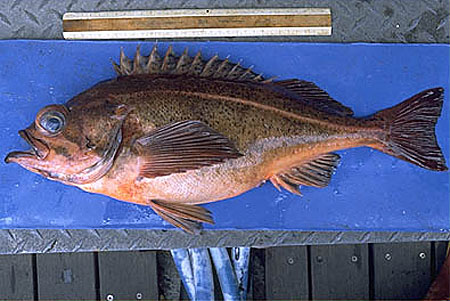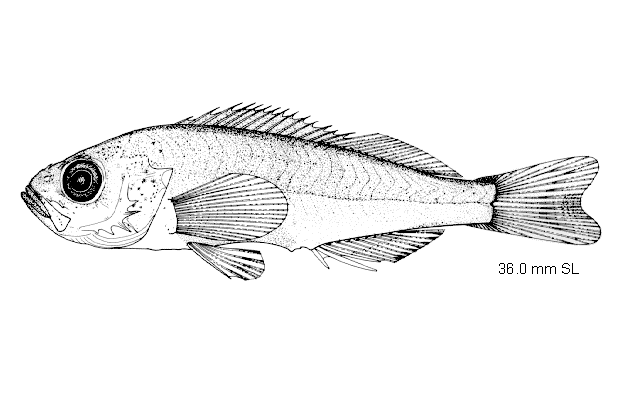Sebastes
rufus
(Eigenmann &
Eigenmann,
1890)
Bank rockfish
View all media / Upload your photos and videos
Expand all
Classification / Names
Teleostei (teleosts) > Perciformes/Scorpaenoidei (Scorpionfishes) >
Sebastidae (Rockfishes, rockcods and thornyheads)
> Sebastinae
Etymology: Sebastes: Greek, sebastes = august, venerable (Ref. 45335).
More on authors:
Eigenmann &
Eigenmann.
Environment / milieu / depth range / climate zone / distribution range
Marine; demersal; depth range 31 - 247 m (Ref. 2850); subtropical; 46°N - 28°N125°W - 114°W.
Distribution
Eastern Pacific: Oregon (Ref. 45591), Fort Bragg in northern California, USA to central Baja California and Guadalupe Island (off northern central Baja California) in Mexico.
Maps

Sebastes rufus / Native range
AquaMaps Data sources:
GBIF
OBIS
This map was computer-generated and has not yet been reviewed.

Sebastes rufus / Suitable habitat
AquaMaps Data sources:
GBIF
OBIS
This map was computer-generated and has not yet been reviewed.

Sebastes rufus / Point map
AquaMaps Data sources:
GBIF
OBIS
This map was computer-generated and has not yet been reviewed.

Sebastes rufus / Year 2050
AquaMaps Data sources:
GBIF
OBIS
This map was computer-generated and has not yet been reviewed.
Length at first maturity / Size / Weight / Age
Short description
Biology
Main reference
Eschmeyer, W.N., E.S. Herald and H. Hammann 1983 A field guide to Pacific coast fishes of North America. Boston (MA, USA): Houghton Mifflin Company. xii+336 p. (Ref. 2850)
IUCN Red List Status (Ref. 125652)
CITES (Ref. 131153)
Not Evaluated
CMS (Ref. 116361)
Not Evaluated
Threat to humans
Harmless
More information
- Countries
- FAO areas
- Ecosystems
- Occurrences
- Introductions
- Stocks
- Ecology
- Diet
- Food items
- Food consumption
- Ration
- Common names
- Synonyms
- Metabolism
- Predators
- Ecotoxicology
- Reproduction
- Maturity
- Spawning
- Spawning aggregation
- Fecundity
- Eggs
- Egg development
- Age/Size
- Growth
- Length-weight
- Length-length
- Length-frequencies
- Morphometrics
- Morphology
- Larvae
- Larval dynamics
- Recruitment
- Abundance
- References
- Aquaculture
- Aquaculture profile
- Strains
- Genetics
- Allele frequencies
- Heritability
- Diseases
- Processing
- Mass conversion
- Vision
- Pictures
- Stamps, Coins Misc.
- Sounds
- Ciguatera
- Speed
- Swim. type
- Gill area
- Otoliths
- Brains
Estimates based on models
Preferred temperature (Ref. 123201): 8.4 - 10.6, mean 9.5 °C (based on 8 cells).
Phylogenetic diversity index (Ref. 82804): PD50 = 0.5 [Uniqueness, from 0.5 = low to 2.0 = high].
Bayesian length-weight: a=0.01000 (0.00495 - 0.02022), b=3.09 (2.92 - 3.26), in cm total length, based on LWR estimates for this Genus-body shape (Ref. 93245).
Trophic level (Ref. 69278): 3.8 ±0.5 se; Based on size and trophs of closest relatives.
Resilience (Ref. 120179): Very low, minimum population doubling time more than 14 years (tm=15; tmax=85).
Fishing vulnerability (Ref. 59153): Moderate vulnerability (42 of 100).
Price category (Ref. 80766): Medium; Questionable: based on ex-vessel price for species in this genus.
Nutrients (Ref. 124155): Calcium = 0 [0, 0] mg/100g; Iron = 0 [0, 0] mg/100g; Protein = 0 [0, 0] %; Omega3 = 0 [0, 0] g/100g; Selenium = 0 [0, 0] μg/100g; VitaminA = 0 [0, 0] μg/100g; Zinc = 0 [0, 0] mg/100g (wet weight);



